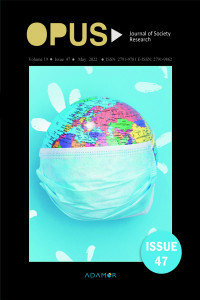Çeperde Mekân Kurulumunun Tarihi: Feminist Otoetnografik Yaklaşım
etnografi, otoetnografi, mekân kurulumu, gündelik hayat, konumsallık, enformel yerleşimler
Herstory of the Periphery: Approaching Placemaking through Feminist Autoethnography
ethnography, autoethnography, place making, everyday life, positionality, informal settlements,
___
- Adams, T. E., Holman Jones, S. & Ellis, C. (2015). Autoethnography: Understanding Qualitative Research. New York: Oxford University Press.
- Aleksiyeviç, S. (2016). Kadın Yok Savaşın Yüzünde. İstanbul: Kafka Kitap.
- Ascensão, E. (2016). The slum multiple: A cyborg micro-history of an informal settlement in Lisbon. International Journal of Urban and Regional Research, 39(5), 948-964.
- Benson, K. & Nagar, R. (2006). Collaboration as resistance? Reconsidering the processes, products, and possibilities of feminist oral history and ethnography. Gender, Place and Culture, 13(5), 581–592.
- Chang, H. (2016). Authoethnography as Method. New York: Routhledge.
- Daniels, D. (2002). Using the life histories of community builders in an informal settlement to advance the emancipation and development of women. R. M. Cervero, B. C. Courtenay & C. H. Monaghan (Eds.), In The Cyril O. Houle Scholars in Adult and Continuing Education Program Global Research Volume 2 (pp.56-69). Athens, GA: University of Georgia Press.
- Grosz, E. (2000). Histories of a feminist future!. Signs, 25(4), 1017-1021.
- High, S. (2011). Mapping memories of displacement: oral history, memoryscapes, and mobile methodologies. S. Trower (Ed.), In Place, Writing, and Voice in Oral History (pp. 217-232). New York: Palgrave Macmillan.
- Iared, V. G. & de Oliveira, H. T. (2017). Walking ethnography and interviews in the analysis of aesthetic experiences in the Cerrado. Ambiente & Sociedade, 20(3), 97-114.
- Kelly, L., Burton, S. & Regan, L. (1994). Researching women’s lives or studying women’s oppression? reflections on what constitutes feminist research. M. Maynard & J. Purvis (Eds.), In Researching Women’s Lives from a Feminist Perspective (pp. 27-48). London: Taylor & Francis.
- Kohl, E. & McCutcheon, P. (2015). Kitchen table reflexivity: negotiating positionality through everyday talk. Gender, Place & Culture: A Journal of Feminist Geography, 22(6), 747-763.
- Lee, J. & Ingold, T. (2006). Fieldwork on foot: perceiving, routing, socializing. S. Coleman & P. Collins (Eds.), In Locating the Field: Space, Place and Context in Anthropology (pp. 67-86). London: Bloomsbury Academic. Önen, S. (2016). Kenti yürüyerek keşfetmenin sosyolojisi. İdealkent, 7(18), 286 – 303.
- Pink, S. (2008). An urban tour: the sensory sociality of ethnographic place-making. Ethnography, 9(2), 175–196.
- Scott, J. W. (1986). Gender: a useful category of historical analysis. The American Historical Review, 91(5), 1053-1075.
- Author 1, 2021
- Author 1, 2022
- Author 1, forthcoming 2023
- Author 2, 2023, forthcoming
- Yayın Aralığı: Yılda 6 Sayı
- Başlangıç: 2011
- Yayıncı: ADAMOR Toplum Araştırmaları Merkezi
Roman Kadınların Toplumsal Cinsiyet Eşitliğine Yönelik Bakış Açıları: Mersin'de Nitel Bir Araştırma
Yükselen Pazarlar için Marka Aktivizmi Girişimlerinin Sosyal Etkisi ve İçgörüler
Didem Gamze IŞIKSAL, Peren OZTURAN, Elif KARAOSMANOĞLU
Çeperde Mekân Kurulumunun Tarihi: Feminist Otoetnografik Yaklaşım
Leyla BEKTAŞ ATA, Simten COSAR
Job-Occupation Choice and Happiness at Work of Refugees: A Cross-Country Qualitative Research
Seher YASTIOĞLU, Ali Murat ALPARSLAN
Özge Nur KOCABAŞOĞLU, Özen BAŞ, Perrin ÖĞÜN EMRE
Popülizmin Türkiye’de Bibliyometrik AnaliziPopülizmin Türkiye’de Bibliyometrik Analizi
Eda ÜNLÜ SAĞDIÇ, Oğuzhan ÇOLAKKADIOĞLU, Sezai DEMİR
A Study on the Appearance of the Kahramanmaraş Earthquake on Social Media
